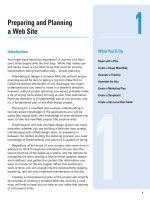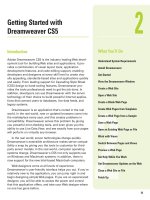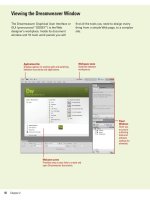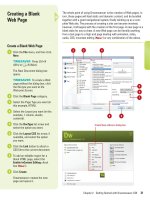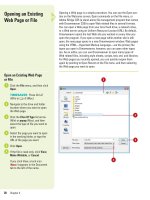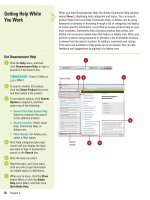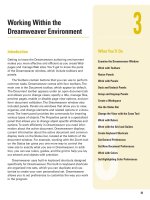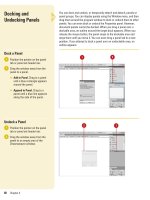adobe dreamweaver cs5 on demand part 70 pptx
Bạn đang xem bản rút gọn của tài liệu. Xem và tải ngay bản đầy đủ của tài liệu tại đây (833.23 KB, 6 trang )
ptg
434 Chapter 18
Creating Repeating
Regions
Create a Repeating Region
Open the template you want to add
a repeating region.
Select the content in the template
you want to change, or click to
place the insertion point where
you want it.
Click the Insert menu, point to
Template Objects, and then click
Repeating Region.
The New Editable Region dialog
box opens.
Enter a unique name for the new
region.
Click OK.
The repeating region appears with
the name in the tab.
NOTE
If the area is to contain
text, make sure you apply any
formatting options, using HTML or
CSS to the area before making it
an editable area.
5
4
3
2
1
Repeating regions are unlocked areas that allow you to add or delete
copies of the repeating regions in a template page. There are two types
of repeating regions: region and table. With a repeating region, you can
specify the layout you want by duplicating repeating page elements,
such as a gallery of photographs. With a repeating table region, you
can increase or decrease the rows in a table while keeping the table
structure intact. You can define table attributes and set which table
cells are editable.
2
3
1
5
4
Did You Know?
You can add, delete and change the
order of a repeating region entry.
Open
the template-based page, place the
insertion point, and then click the Plus
(+), Minus (-), Down Arrow, or Up
Arrow buttons to change the entries.
You can also use the Repeating Entries
submenu on the Edit menu to cut, copy,
and paste entries.
From the Library of Wow! eBook
ptg
Chapter 18 Creating Templates 435
Create a Repeating Table
Open the template you want to add
editable regions.
Click to place the insertion point
where you want to insert the table.
Click the Insert menu, point to
Template Objects, and then click
Repeating Table.
Select from the following options
in the Insert Repeating Table
dialog box:
◆ Rows. Enter the number of
rows for the table.
◆ Columns. Enter the number of
columns for the table.
◆ Cell Padding. Specify the
number of pixels between a
cell’s contents and the cell
border.
◆ Cell Spacing. Specify the
number of pixels between the
table cells.
◆ Width. Enter the width (in
pixels) or as a percentage of
the browser window’s width.
◆ Border. Enter the width (in
pixels) for the table border.
◆ Repeat Rows Of The Table.
Specify the table rows you
want in the repeating region.
◆ Starting Row. Enter the row
number for the first row.
◆ Ending Row. Enter the row
number for the last row.
◆ Region Name. Enter a unique
name for the table region.
Click OK.
The repeating table region
appears with the name in the
table.
5
4
3
2
1
5
4
From the Library of Wow! eBook
ptg
436 Chapter 18
Creating Optional
Regions
Create a Non-Editable Optional
Region
Open the template you want to add
an optional region.
Select the item, or an AP element
within the template that you want
converted into an optional region.
Click the Insert menu, point to
Template Objects, and then click
Optional Region.
Click the Basic tab.
Enter a unique name for the
region.
Select the Show By Default check
box to toggle between showing or
hiding this optional region (default:
show).
To set val ues for the o ptio nal
region, click the Advanced tab.
◆ Click the Use Parameter option,
and then select a parameter
from the popup, or click the
Enter Expression option, and
then write a template
expression.
Click OK.
8
7
6
5
4
3
2
1
Content within an optional region may or may not be displayed,
depending on certain conditions set by the template designer. Optional
regions are just that: optional. Optional regions define content or
editable regions that you can turn on or off (be visible or not). Optional
regions, therefore, enable designers to show and hide specially marked
regions. The template tab of an optional region is preceded by the word
If
. There are two types of optional regions: non-editable and editable. A
non-editable optional region allows you to show or hide the region
without the ability to edit the content, while an editable optional region
allows you to edit the content.
1
3
2
7
5
8
4
6
From the Library of Wow! eBook
ptg
Chapter 18 Creating Templates 437
Create an Editable Optional
Region
Open the template you want to add
an optional region.
Click to place the insertion point
where you want to insert an
editable optional region.
Click the Insert menu, point to
Template Objects, and then click
Optional Region.
Click the Basic tab.
Enter a unique name for the
region.
Select the Show By default check
box to toggle between showing or
hiding this optional region.
To set val ues for the o ptio nal
region, click the Advanced tab.
◆ Click the Use Parameter option,
and then select a parameter
from the popup, or click the
Enter Expression option, and
then write a template
expression.
Click OK.
8
7
6
5
4
3
2
1
7
8
4
Did You Know?
You can change the settings for an
optional region.
Select the optional
region, open the Properties panel, and
then click the Edit button.
You can modify optional regions tem-
plate parameters.
Open the template-
based page, click the Modify menu,
click Template Properties, select the
property you want to change, edit the
value of the property, select or clear
the Show check box, select or clear
the Allow Nested Templates To Control
This check box, and then click OK.
Creating an Optional Region
A simple use of an optional region is to allow content to either be visi-
ble or not in a page based on a template. For example, you maintain a
Web site for a garden center called the Green Thumb (now that's
original). The site sells three types of items: Flowers, Vegetables, and
Garden Equipment. The pages are essentially the same. There will be
two editable areas: one describing the product, and another for an
image displaying the product. The remainder of the areas (navigation,
footers, background, etc.), are all locked… except for one thing. You
want a generic image on each of the pages so that the customer can
identify the pages for the three products (it could even be a back-
ground image contained in an AP element). To solve this problem, you
create an optional region, load all three changeable images into the
area, and then let the designer of the page decide which image to
use.
Design By Example
From the Library of Wow! eBook
ptg
438 Chapter 18
Creating InContext
Editing Editable
Regions
Create an InContext Editing
Editable Region
Open the Web page that you want
to transform into an ICE repeating
region.
Do any of the following to select
the region that you want to make
editable:
◆ Select a div, th, or td tag.
◆ Place the insertion point or
select content.
◆ Select one editable region in a
template.
Click the Insert menu, point to
InContext Editing, and then click
Create Editable Region.
Based on your selection in Step 2,
take the appropriate action:
◆ If you selected a div, th, or td
tag, you’re done.
◆ If you placed the insertion point
or selected content, select an
option to create a new editable
region, and then click OK.
◆ If you selected one editable
region in a template, click OK.
4
3
2
1
Adobe InContext Editing (ICE) is an online service that allows users to
make simple edits to your web pages without any previous knowledge
of HTML code or web editing. Before a user can edit a page, you need
to specify what areas on the page that you want to enable users to edit
directly in a browser. You can specify areas of a page for users to edit
by creating an ICE editable region. An ICE editable region is a pair of
HTML tags that includes the ice:editable attribute in the opening tab.
These tags transform a non-editable region of a page into an editable
one. To edit a page, a user opens the page in a browser, logs in to the
InContext Editing service, and then edits the content in the ICE editable
region. If you are creating an ICE editable region to a template, the new
ICE editable region must be placed within an editable region. For
details about using the Adobe ICE online editing service, see the Adobe
web site at
www.adobe.com
.
1
32
4
From the Library of Wow! eBook
ptg
Chapter 18 Creating Templates 439
Click the blue tab of the editable
region to select it.
Specify the editing options that
you want to make available to
users in the Properties panel.
The options you select in the
Properties panel will be available
to users when they edit the page
in a browser.
Click the File menu, and then click
Save.
If prompted, click OK for
Dreamweaver to add supporting
files to your site for ICE. These
files need to be uploaded to your
server for ICE to work properly.
Delete Editable Region
Open the Web page with the ICE
editable region.
Select the editable region that you
want to delete.
Click the Remove Region button in
the region’s Properties panel.
Click OK to confirm the removal.
4
3
2
1
8
7
6
5
7
5
Click to display options
6
1
2
3
4
From the Library of Wow! eBook
